For a printable version of the newsletter with photos click here.
We want you to also think: Farmers. Placing farms in outlier areas was a major strategy of empire in thousands of border wars.
Agricultural settlements caused fighting from the beginning, because settlements infringed on territory that hunter-gatherer tribes needed for sustenance on a seasonal basis. This seasonal aspect of course meant that large reaches of land were uninhabited for much the year.
Imagine coming upon nature ripped to shreds for fields and buildings where just last year you’d still harvested spring roots, a tribal tradition at this location for untold generations. Typically, good farm ground would previously have grown the best bounty of edible wild plants, which only exacerbated the conflict that was sure to ensue. And after livestock domestication, herding nomads too roamed the land in search of pasture, further encroaching upon gatherer-hunters’ territorial needs of survival.
For the settlers, quick population growth was imperative to assure safety in numbers, since wandering tribes were limited by the logistics of hunting and gathering; for nomads it was simply impractical to form bands much larger than a hundred people, the daily trek to seasonal gathering sites too far, too much effort.
Of course, it wasn’t just safety in numbers for first settlers, they also had to possess a warrior streak when it came to warding off attack and raid. This would change when city-states and then empires in the Fertile Crescent, Egypt, and around the Mediterranean established armies by recruiting fighters who specialized in warfare. And farming became the work of slaves, to a large extent.
In the Europe north of Alps and Pyrenees, the first-settlement scenario of strife and fight, the seesaw of suffering raids and then rebuilding, was part of life for many centuries.
Then there were the Allemannen, who by push and shove ended up in what’s Swabia today. Settled there for some time, they entered into contracts to raise grain for the Romans in the region the Romans called Agri decumantes – “Tithe Lands.”
If they were good farmers for the Romans, the Allemannen grew ever more aggressive in expanding their territory. They were slapped down by King Chlodwig of the Salier Franks. After a short alliance with the Goths, the Allemannen became part of the Franks.
Things settled down somewhat after Charlemagne’s wars consolidated western Europe, culminating in his being crowned by the pope in 800. The Germanic splinter of the Franks would eventually become the Franconians, their lands today between the rivers Danube and Main, the northern part of the German state of Bavaria.
A sometimes romanticized interweaving of warring and farming can be seen in the Vikings during this era.
As the warring wanderings of Europe’s peoples stabilized, the centrally located, high-walled castles and towns became fairly defensible. But many lands still laid wide-open. It behooved the rulers of the emerged kingdoms and empires to secure their borderlands. The farther out they could establish an infrastructure, the safer their core regions.
For such frontier protection strategy the kings lured farmers.
The farmers chosen for borderlands vanguard were German peasants, quite often. In the Middle Ages, Polish knights asked for German farmers to settle in some of their outlier regions. Hungarian Kings did the same when they wanted to secure their eastern borderlands in Transylvania; most of that German farmer migration occurred under the reign of Géza II, King of Hungary and Croatia in the 1140s.
By then a new stripe of nomadic culture had ascended. No longer bands of a hundred or so, these were horse people fierce enough to support a large population by herding livestock and by raiding. Again and again they formed hordes and swooped into others’ borderlands. Transylvania was especially plagued by a nomadic tribe called the Cumanians who, attacking from the east repeatedly, caused much devastation. The Tartars wreaked so much havoc in 13th-century Transylvania that some regions emptied of people.
Farmers aren’t stupid, they knew they were exposing themselves to great risk were they to settle borderlands. They went there nevertheless because they were offered considerable incentives. (And, the opportunity of farming virgin land has an enthralling, even transfixing hold on farmers’ minds – we’ll talk about that in another chapter.)
Incentives for the Transylvania Saxons included economic privileges, a largely autonomous government, and, very importantly, citizen status. This made the social climb to the lower ranks of nobility a relatively fluid affair. In fact, the Transylvania Saxons are mostly known for their great towns that mirrored Central Europe’s glorious building; craftsmen thrived in what became Transylvania’s Golden Age for culture, science, art, trade: Cluj Napoca (Klausenstadt), Sibiu (Hermannstadt), Sighisoara (Schässburg), Brasov (Kronstadt) and a few other Saxon towns attract most of the tourists to Transylvania to this day. But outside the cities many Germans continued on as farmers, evidence of this the wide-street villages they built in quite different style than the Romanians built theirs.
Since social rise from the ranks of farmers was much less possible for the Romanians who’d remained in the region since Dacian times, those Romanians became the underclass. When Romania was awarded Transylvania in the wake of World War One, and the government moved more Romanians into Siebenburgen, relations with the non-integrating Germans became ever more strained; the war crimes of the Transylvania Saxons in the Second World War were the last straw – after the war it was the Germans who were suppressed. The communist dictator Nicolae Ceausescu sold many of the Transylvania Saxons to the West German government that resettled them in Germany; most remaining Germans left Romania in the early 1990s after the fall of communism. Today the ethnic Germans in Siebenburgen number less than 2 percent of the population, only about one tenth of the former Transylvania Saxon population of 550,000 still live in Romania. (Meanwhile, the Swabians who emigrated to Romania’s Banat in later centuries had integrated, and many of their descendants remain.)
The best known farmer settlement in borderlands was instigated in the 1760s by a woman from an obscure German place called Zerbst. As it happens, she is a connection to present-day America: in several Midwest states and on the Columbia Plateau live farmers whose family lore tells of 18th-century forebears encountering this woman on an occasion proud and serene.
Her name was Sophie Auguste Friederike von Anhalt-Zerbst. By her own account her childhood was “nothing of interest” – that she would develop a Machiavellian streak while attaining a Marilyn Monroe notoriety was not sung her in the cradle.
According to a German documentary, the marriage between Sophie and the crown prince Peter of Russia was an arranged alliance. Not a small coup for her family, because even though their ranking was high aristocracy – Sophie a princess –, financially they were in troubled waters. On the Russian side the deal was shaky because the reigning Tsaritsa Elizabeth bore no children (not officially, anyway) and so had to resort to much manipulation in maneuvering her nephew Peter into place for succession on the throne.
At 16, in 1745, Sophie is determined to become a full-fledged Russian. To the chagrin of her Lutheran parents she changes her religion to Russian Orthodoxy, at which point she accepts as her name Catherine (“Yekaterina Alexeevna”) in honor of Empress Elizabeth’s mother.
Catherine detests Peter from the get-go. Not long before she starts having affairs, but affairs not with anyone (as was the case with empress Elizabeth), no, Catherine chooses for her lovers politically, diplomatically, and militarily high-placed men. When her marriage with Peter fails to produce offspring, Catherine carries on her love assignations with the tacit approval of Elizabeth. There is no certainty who fathered Catherine’s first son, the future Tsar Paul. Born in 1754, baby Paul is immediately appropriated by Elizabeth.
Elizabeth dies 1761. Peter now is Tsar, Peter III. A mere six months after he begins his reign, Catherine activates her web of lover-conspirators. A coup d’état disposes of Peter who is murdered in prison. Now Catherine is Tsaritsa.
History knows her as the only woman sovereign to claim the titular “The Great,” because her 34-year reign did make Russia great. Some historians go so far as to state that it was Catherine who build Russia up to a true empire.
Economy, military, art, sciences – Catherine the Great’s far-reaching accomplishments are well documented, and on the personal level she was intellectually alert. Just one correspondence, with the French philosopher Francois-Marie Arouet (who’s better known under his pen name Voltaire), amounted to 800 letters. Another Age-of-Enlightenment great, Denis Diderot, she enticed to spent time at her court. But her excitement over the zeitgeist was strictly an intellectual exercise. When Diderot realized that Russian peasants still suffered serfdom as primitive as that of the Middle Ages, he left Catherine’s court in disgust. “The soul of Brutus in the body of Cleopatra,” Diderot described her. In 1774 she put down a Cossack and farmer uprising with excessive cruelty, and when the French Revolution changed the political scape of Europe, Catherine turned her back on Enlightenment.
What pertains to the American connection are Catherine’s Einwanderungsmanifeste of 1762 and 1763, manifestos that invited Europe’s farmers to settle along the lower Volga, a border region encroached upon by marauding horse tribes, and also from the Turks whose Ottoman Empire was keen on expansion as well. Catherine’s incentives for relocating farmers: financial help for start-up farms; religious freedom and equality except for Jews; tax advantages for 30 years; exemption from conscription into military service; and, a promise that the immigrants could retain their cultural identity and establish a fair degree of self-government.
In German regions, too, the manifesto elicited no response initially. Catherine then sent emissaries who offered the German counts monies. That did the trick.
It wasn’t that farmers wouldn’t take matters into their own hands – when they could: especially during wartime upheaval many of them went down the Rhine to the seaports from where they sailed to America, and after the aristocracy closed the river to them they made their way overland across France to the ports. In some regions there existed a legal means to leave, farmers could buy themselves free by paying up to 200 Gulden. So great became the exodus that, in 1770, the authorities of Hesse expressed concern that emigrating country folk might be taking wealth out of the country by silver-plating household items, and took steps to prevent this. By 1784 the consternation of the Hessian rulers led to an edict, emissaries who promised farmers a better life in foreign lands should henceforth be detained.
Emigration to points east was more regulated than the travel through seaports, farmers typically had to present travel papers at several passport checks along the route, and therefore had to resort to official channels for emigration, mostly.
One aspect a novelist could elaborate on were the hasty weddings, since one stipulation in obtaining travel papers to the Volga was that the emigrants were married folk. “Under Catherine's immigration policy – administered, incidentally, by Gregorii Orlov (Catherine’s lover who’d been instrumental in getting rid of Peter III) – Russian officials in Europe were instructed to recruit married couples, and offered financial incentives that led to substantial numbers of young people getting married in the weeks immediately preceding departure,” Scheuerman notes.
“However, there are numerous cases of single men, and some widowed women with children, going to Russia. In the early years 1765-1766 these were exceptions. In the case of my wife Lois's and my ancestral Volga village Yagodnaya Polyana north of Saratov, for example, out of that group of eighty families who departed in the summer of 1766, only one person was single. But in the neighboring village, Pobotschnaya, founded several years later, in 1772, eight of the 32 founders were single men. As time went on, such limitations became less a factor so recruiters could attract more settlers. This reflects the general demographic trend of the immigrants in those early years.”
Scheuerman says that once Catherine’s manifesto began having its desired effect, large numbers of Germans streamed from the countryside to the gathering points. “In Hesse they were offered safe haven at Büdingen, by the House of Isenburg (also spelled Ysenburg). Descendants of the Isenburg Grafen and Fürsten (counts and princes) live there to this day. In Büdingen you can see the square where the emigrating farmers gathered for their journey.” His own progenitors were among 80 families who left together from Büdingen in 1776. The typical traveling ensemble were father, mother, children. “Rarely a third generation went along.”
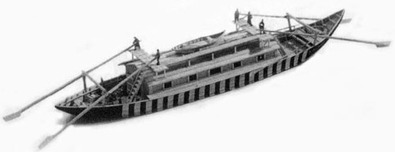
Many chose to leave mid-July, and they were looking at a 2000-mile long overland journey that took at least six months. Quite a few interrupted their trek in St Petersburg. “The old Settlement House in St Petersburg still stands, many of the German emigrants spent the winter there before traveling on to the lower Volga,” Scheuerman says.
A quicker way to the lower Volga – taking a little more than two months – was water travel. Especially emigrants from Württemberg chose that route, gathering at Ulm where they built themselves Ulmer Schachteln (literally: “Ulm Boxes,” the word Schachtel hinting at a flimsy, impermanent type of box, such as a carton or a matchbox). The Ulmer Schachteln were large but rough-hewn, after all, they were one-way boats for drifting down the Danube River toward the Black Sea. Alternately Schwabenplätten (“Swabian boards”) were also built as river conveyance, big rafts with a hut at center. Both, one-way boats and rafts were steered by four long rudders, one on each corner.
In regard to wheat seed traveling from German regions to the Volga, Scheuerman did some sleuthing: “I ran onto a very obscure 19th century reference to the original wheat brought by the Germans to Russia during the reign of Catherine the Great in the 1760s. It was an old landrace called Saxonka and also given the nickname ‘Colonist Wheat.’ I did some detective work with my contacts at the USDA and in Russia, and found that someone saved an accession back around 1910 in Saratov which was shared with the USDA, so a small sample was available.” He had the seeds grown out, although in the western Washington climate the wheat did not yield all that well.
She saw a sturdy fence around each village to keep out livestock. She saw village church, school, flour mill. The typical Hof (village farmstead) consisted of the main house as well as a root cellar and a stone-and-clay shed. In the gardens: squash, cabbage, potatoes, pumpkins, onions, gashernik (berries); young apple and cherry trees.
Tsar Alexander I of Russia repeated Catherine’s manifesto tactic in 1813, to attract German farmers to the borderlands east of the Volga – that group the “Black Sea Germans” –, and to Bessarabia west of the Volga, along the Dniester River. The three groups of German farmer immigrants are collectively the Russlanddeutsche, the Russian-Germans.
Even though Catherine had promised that they could adhere to their own culture, the fact that the Germans did not integrate caused friction with the Russian people and authorities, eventually, Scheuerman points out: “In the 1870s Tsar Alexander III revoked a series of economic and social privileges, so that the Germans might better assimilate into the broader Slavic culture which still held them in suspicion as foreigners. Rather than face compulsory schooling in the Russian language and five years of miserable service in the Russian Army, many German families decided to emigrate to America.”
In the New World they were drawn to the prairie, many settling in North Dakota, some up in Canada, and still others in Kansas and Nebraska. No wonder this, on the Russian steppes they’d become experts in dryland farming big-sky regions. By the time they emigrated they’d adopted Russian wheats, the hard red wheats that were new to America; most famously, the Russian-Germans brought with them the Turkey Red wheat, but with the wheat seed they also carried in, inadvertently, seed of that bane of weeds, the Russian thistle.
America was in a fluid state in the late 1800s, Manifest Destiny the controversial hue and cry fueling imperialist aspirations by expansion to the West, politically; agriculturally this was opportunity to farm and settle virgin lands. The Homestead Act of 1862 was in effect the United States’ incentive for farmers to move to the borderlands at the end of the Oregon Trail.
Many of the Russian-Germans went west; some groups from Nebraska and Kansas arrived in the Pacific Northwest by wagon train, as early as 1881; most came by train once the railroads had pushed through. By 1920 over 20,000 Russian-Germans were living in the Northwest states.
Scheuerman says that the first Russian-German arrivals settled on the west side of Oregon, but after a few years undertook a scouting trip to the Columbia Plateau. Unlike some of the other early pioneers who traversed the Inland Northwest and found it worthless, and also unlike many later arrivals who’d been lured here by false-claims advertisements published by the railroads, and who were appalled by the aridly dusty reality, the Russian-Germans liked what they saw. “Of course, at that time they could chose some of the best farming areas,” Scheuerman says of the first families who settled on the Columbia Plateau.
Drive around the Odessa area today and notice the road signs, Lentz, Kuch, Schlimmer, Janke, etc., all named after Russian-German immigrants. The annual Deutsches Fest of Odessa shows pride in central European heritage, with Bratwurst and Bier, hoompa music and Dirndl dresses completing the picture. Alas, that’s a recent cultural change, Scheuerman emphasizes. He found it difficult to collect historical information on the Russian and the German past of Russian-German families, because in very many cases the parents and grandparents did not pass on those parts of family history.
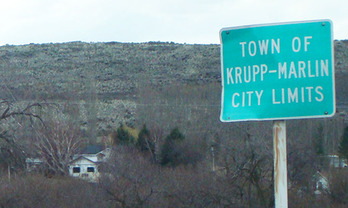
Know your past! is good advice. So what do you do when your forebears’ past in Germany is a black hole?
Lena Lentz Hardt of Lentz Spelt Farms on the Columbia Plateau got ahold of several genealogies that include some of her Russlanddeutsche family branches. This gave her some fixed points on the map of Central Europe (though not as many as she would have liked, in many cases a particular village is cited as birth/marriage/death location, but without that village location being identified by nearest town or county; this is a problem because many village names occur in multiple regions of Germany).
Armed with her genealogies, Lentz flies an Airbus from Seattle direct to Frankfurt.
What she finds out about her ancestors in 1700s Germany, and German farmers’ lot in medieval times leading up to then, is the next chapter. Suffice to say that the story she puts together is a tapestry of so many a warp and weft – some frayed, others strong –, a tapestry of such a multitude of colors and textures as to engender a kaleidoscope effect.
We’ll give this away: Lentz will order an apple strudel at a Franconian restaurant, only to be told by the chef that Apfelstrudel is boring food. Lentz lets herself be talked into having a dessert of local interest instead: hot pear slices in a sauce of caramelized brown sugar and black pepper, yes, black pepper; the accompanying scoop of vanilla ice cream is crowned with balsamic vinegar, yes, vinegar. Lentz finds it absolutely toothsome. Ah, isn’t this a gourmet metaphor of the Middle Ages...
Meanwhile, her search fits right in with the view of agriculture as a movable world.


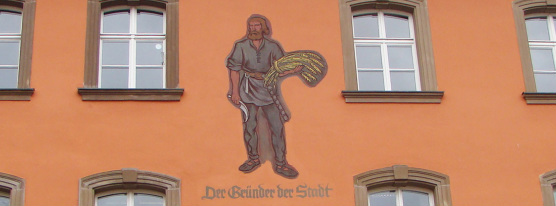
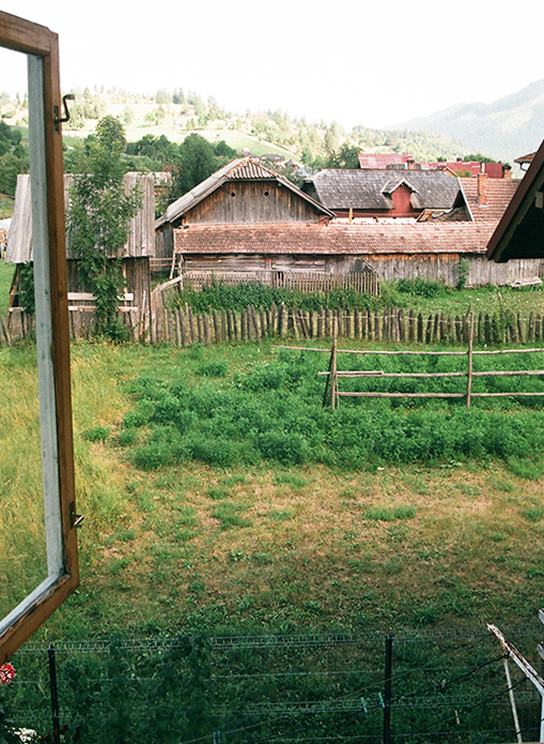
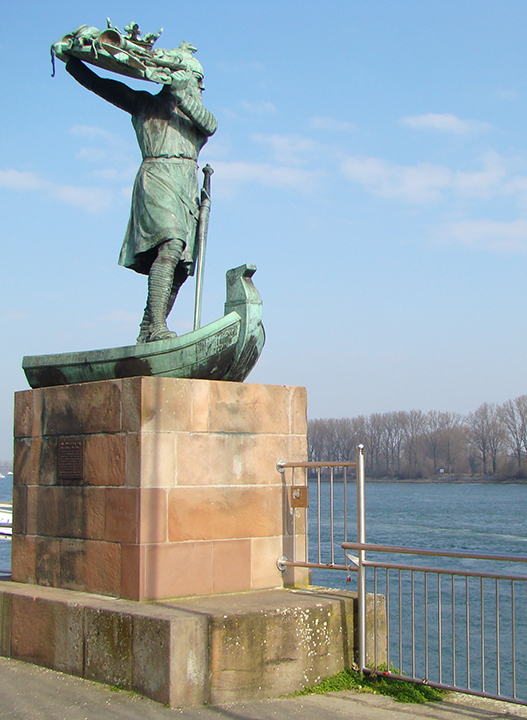
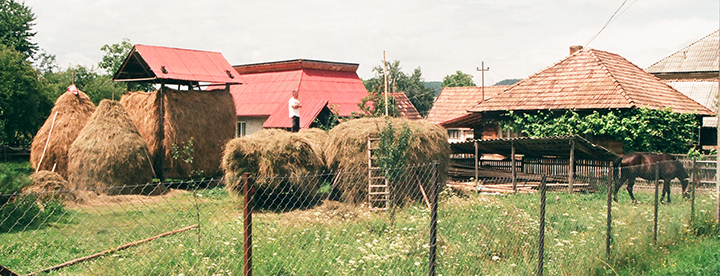
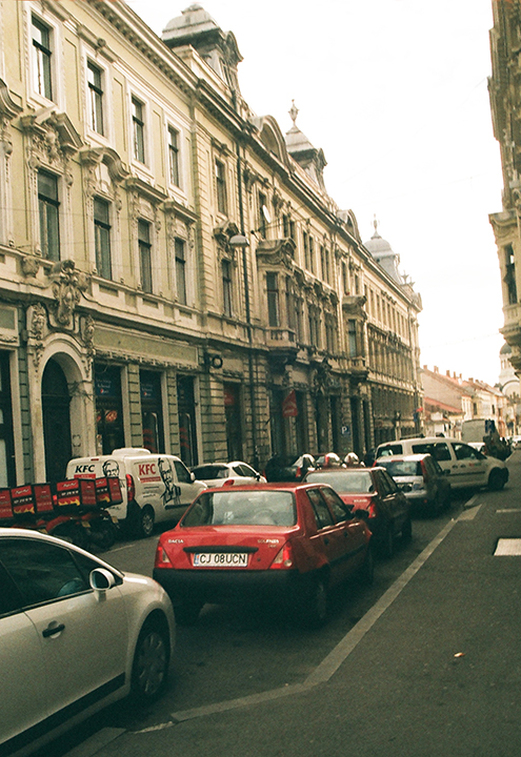
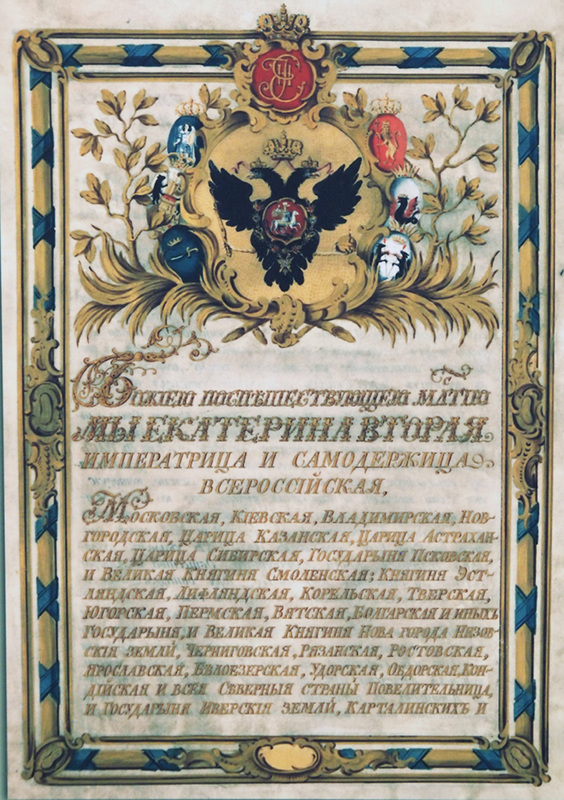
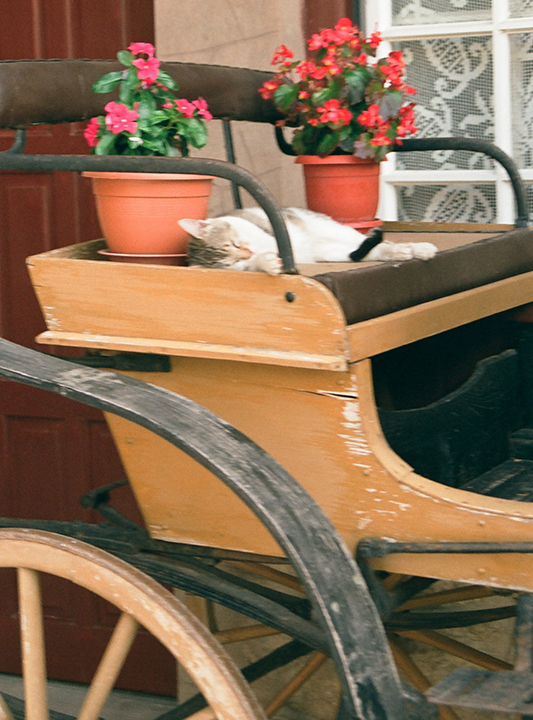
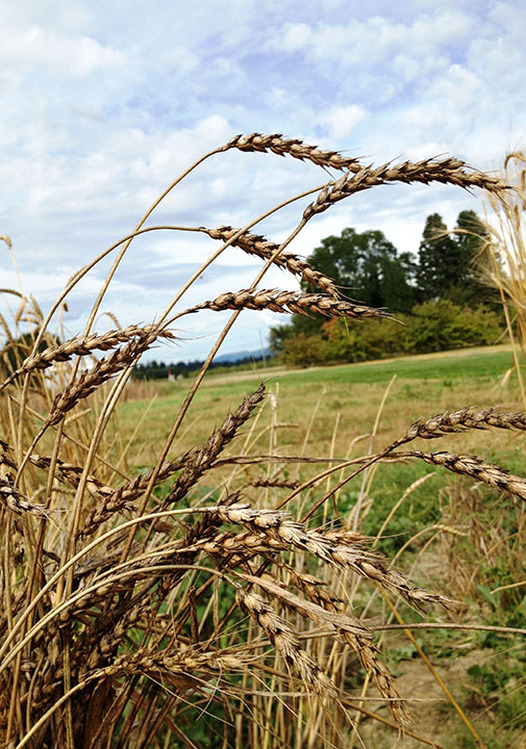

 RSS Feed
RSS Feed